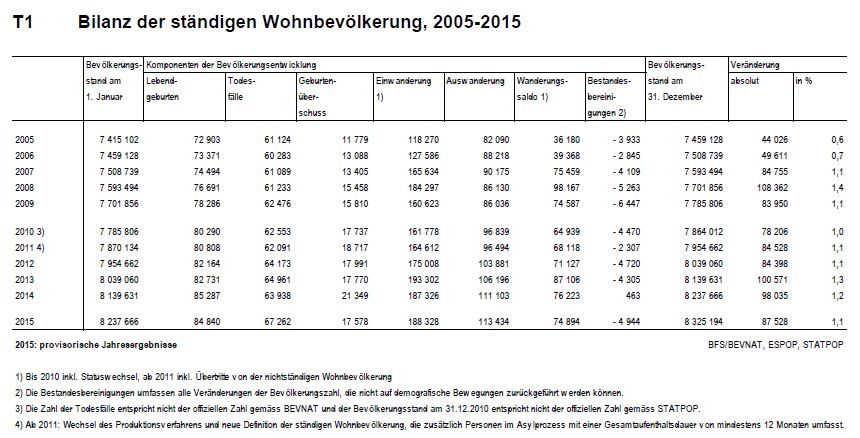21.04.2016 09:15 – FSO, Demography and Migration (0353-1604-10) Provisional results on population change in 2015 The population is growing and ageing: Grew by 1.1% in 2015 Neuchâtel, 21.04.2016 (FSO) – Switzerland’s population grew by 1.1% in 2015. This trend is the result of net migration and natural growth which are both positive. The population continues to age, in particular Swiss nationals. These are some of the provisional results from the Federal Statistical Office’s Population and Household Statistics. Changes in Switzerland’s population are driven by immigration – and this is reflected in the currency!In 2015, population rose by 87’528 (1.1%). About 80% of them were contributed by net immigration and 20% by natural change (births minus deaths).Interesting facts: Still in 2005, the natural change was 11’779. This rose to 21’349 in 2014 and slowed down to 17’578 in 2015. The slow-down could have been caused by longer working hours that many companies introduced as reaction to the end of the EUR/CHF. In 2008, during the recession, the net immigration to Switzerland was highest with nearly 100’000. A lot of Germans came. 3.24 Mio are women of Swiss nationality, but only 3.03 Mio are men with the Swiss nationality 1.09 Mio are men of foreign nationality, but only 0.96 Mio are women of foreign nationality.
Topics:
Swiss Statistics considers the following as important: Featured, newsletter, Swiss Macro
This could be interesting, too:
Eamonn Sheridan writes CHF traders note – Two Swiss National Bank speakers due Thursday, November 21
Charles Hugh Smith writes How Do We Fix the Collapse of Quality?
Marc Chandler writes Sterling and Gilts Pressed Lower by Firmer CPI
Michael Lebowitz writes Trump Tariffs Are Inflationary Claim The Experts
21.04.2016 09:15 – FSO, Demography and Migration (0353-1604-10)
Provisional results on population change in 2015
The population is growing and ageing: Grew by 1.1% in 2015
Neuchâtel, 21.04.2016 (FSO) – Switzerland’s population grew by 1.1% in 2015. This trend is the result of net migration and natural growth which are both positive. The population continues to age, in particular Swiss nationals. These are some of the provisional results from the Federal Statistical Office’s Population and Household Statistics.
Changes in Switzerland’s population are driven by immigration – and this is reflected in the currency!
In 2015, population rose by 87’528 (1.1%). About 80% of them were contributed by net immigration and 20% by natural change (births minus deaths).
Interesting facts:
- Still in 2005, the natural change was 11’779. This rose to 21’349 in 2014 and slowed down to 17’578 in 2015. The slow-down could have been caused by longer working hours that many companies introduced as reaction to the end of the EUR/CHF.
- In 2008, during the recession, the net immigration to Switzerland was highest with nearly 100’000. A lot of Germans came.
- 3.24 Mio are women of Swiss nationality, but only 3.03 Mio are men with the Swiss nationality
- 1.09 Mio are men of foreign nationality, but only 0.96 Mio are women of foreign nationality.
- According to figures from “20 Minuten”, Less Germans immigrate into Switzerland and – since the last month – more Germans leave than they come.
France (5136), Italy (3957), Portugal (3682), Kosovo (3490) and Poland (2781) lead the net immigration figures.- Read also the Two phases of CHF appreciation and what is in between. I explain why CHF weakens in between the two phases of CHF appreciation.
The “in between phase” is the phase, when less people come to Switzerland. With the next recession, more will come again.

